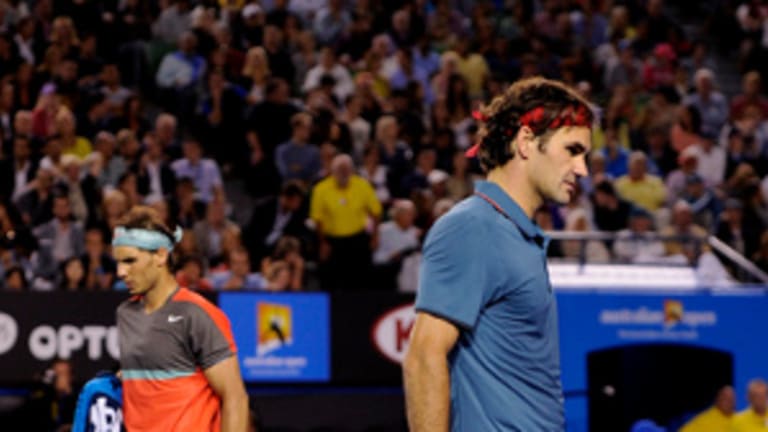MELBOURNE—There are always a few points in any tennis match that can be pulled out and held up as representative, as microcosms of the contest as a whole. And there were plenty in Rafael Nadal’s 7-6 (4), 6-3, 6-3 win over Roger Federer here on Friday night.
There was the sitter swing volley that Federer drilled into the tape from point-blank range late in the third set. He knew from experience that he couldn't just play a safe putaway shot against Rafa.
There was the reflex forehand flick pass, hit at full stretch, by Nadal to give himself two break points at 2-3 in the third set. All night he had been reacting and feeling the ball well.
And, in the end, there was the final forehand over the baseline from Federer, which is how umpteen—or more—matches between these two have concluded in the past. That shot is the Fedal Rafa-Rog rivalry in a nutshell: Nadal makes Federer press, and miss.
But the moment that I thought summed up Nadal’s 23rd win in their 33 matches wasn’t one that will likely live on in anyone else’s memory. Rafa was already up two sets, and Federer was serving at 3-5 in the third. At 15-0, Federer tossed the ball to hit a second serve, but before it reached its peak, before it was at all clear to anyone else where he would hit it, Nadal had already taken a huge step to his right to look for a forehand. On cue, Federer’s serve spun right into Rafa’s strike zone. He hit his return like he had all the time in the world, and seemed to place the ball with a little extra precision and care in the corner, far from Federer’s reach. There it was again, the same scenario after all of these years: Federer comes into a match against Rafa looking like the champion of old, looking like he might have the answer this time, only to find that Nadal is still one step, one shot, one thought, ahead of him.
Nadal was timing the ball crisply from the start tonight; he had, as they in the NBA, “good energy.” His forehand, as always, was heavy and controlling, but he also used his backhand to neutralize the Federer attack. Best of all were his passing shots, which were as accurate as they’ve ever been. Federer had dominated the net in his last two matches, against Jo-Wilfried Tsonga and Andy Murray, but he was just 23 of 42 up there tonight. Despite making only 64 percent of his first serves, Nadal was able to avoid facing a break point until the third set.
The first question Nadal was asked afterward was: “You couldn’t play much better out there tonight. Can you agree?”
Rafa, never one for self-satisfaction, seemed to consider disputing the reporter for a second, then said the hell with it and admitted:
“I played well tonight.”
By the second question, Nadal had thrown all of his usual caution out the window and revised his assessment upward:
“I think I played great.”
It was apparent from the start, in case we had forgotten, that Rafael Nadal is not Jo-Wilfried Tsonga. Nor is he Andy Murray. In the first set, the forays to the net that worked for Federer against those two weren’t working anymore. By the middle of the second set, Federer was struggling to get to the net at all. The player who had come in looking to take back the forecourt was stuck behind the baseline retrieving Nadal’s diving and hooking sidespin, exactly where he didn’t want to be. Nadal said that he paid special attention to his service placement and the depth of his ground strokes tonight, in order to “resist,” as he said, any Federer assault.
